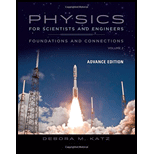
Concept explainers
(a)
Volume flow rate between the two sections of the hose having a pressure difference
(a)
Answer to Problem 67PQ
The volume flow rate between the two sections of the hose having a pressure difference
Explanation of Solution
Bernoulli’s theorem states that the energy stored in the olive oil flowing through both narrow and wide part of hose is constant.
Apply Bernoulli’s theorem in the given situation.
Here,
Apply the continuity equation to find the relation between the velocities of oil in both parts of the hose.
Here,
Both wide and narrow parts of the hose are same height. Therefore,
Rewrite equation (I) to find
Here,
Write the equation to find the volume flow rate of the wide part of hose.
Here,
Write the equation to find the volume flow rate of the narrow part of hose.
Here,
Write the equation to find the area of the wide part of hose.
Here,
Write the equation to find the area of the narrow part of hose.
Here,
Write the equation to find the radius of wide part of hose.
Here,
Write the equation to find the radius of narrow part of hose.
Here,
Conclusion:
Substitute
Substitute
Substitute
Substitute
Substitute
Substitute
Rearrange for
Substitute
Substitute
Therefore, the volume flow rate between the two sections of the hose having a pressure difference
(b)
Volume flow rate between the two sections of the hose having a pressure difference
(b)
Answer to Problem 67PQ
The volume flow rate between the two sections of the hose having a pressure difference
Explanation of Solution
Refer sub part (b).
Substitute
Substitute
Rearrange for
Substitute
Substitute
Conclusion:
Therefore, the volume flow rate between the two sections of the hose having a pressure difference
Want to see more full solutions like this?
Chapter 15 Solutions
Physics for Scientists and Engineers: Foundations and Connections, Advance Edition, Volume 2
- Liquid toxic waste with a density of 1752 kg/m3 is flowing through a section of pipe with a radius of 0.312 m at a velocity of 1.64 m/s. a. What is the velocity of the waste after it goes through a constriction and enters a second section of pipe with a radius of 0.222 m? b. If the waste is under a pressure of 850,000 Pa in the first section of pipe, what is the pressure in the second (constricted) section of pipe?arrow_forwardA tank with a flat bottom of area A and vertical sides is filled to a depth h with water. The pressure is P0 at the top surface. (a) What is the absolute pressure at the bottom of the tank? (b) Suppose an object of mass M and density less than the density of water is placed into the tank and floats. No water overflows. What is the resulting increase in pressure at the bottom of the tank?arrow_forward(a) Calculate the absolute pressure at an ocean depth of 1 000 m. Assume the density of seawater is 1 030 kg/m3 and the air above exerts a pressure of 101.3 kPa. (b) At this depth, what is the buoyant force on a spherical submarine having a diameter of 5.00 m?arrow_forward
- (a) A water hose 2.00 cm in diameter is used to fill a 20.0-L bucket. If it takes 1.00 min to fill the bucket, what is the speed v at which water moves through the hose? (Note: 1 L = 1 000 cm3.) (b) The hose has a nozzle 1.00 cm in diameter. Find the speed of the water at the nozzle.arrow_forwardA spherical submersible 2.00 m in radius, armed with multiple cameras, descends under water in a region of the Atlantic Ocean known for shipwrecks and finds its first shipwreck at a depth of 1.75 103 m. Seawater has density 1.03 103 kg/m3, and the air pressure at the oceans surface is 1.013 105 Pa. a. What is the absolute pressure at the depth of the shipwreck? b. What is the buoyant force on the submersible at the depth of the shipwreck?arrow_forward(a) Suppose a blood vessel's radius is decreased to 90.0% of its original value by plaque deposits and the body compensates by increasing the pressure difference along the vessel to keep the flow rate constant. By what factor must the pressure difference increase? (b) If turbulence is created by the obstruction, what additional effect would it have on the flow rate?arrow_forward
- (a) What is the density of a woman who floats in freshwater with 4.00% of her volume above the surface? This could be measured by placing her in a tank with marks on the side to measure how much water she displaces when floating and when held under water (briefly). (b) What percent of her volume is above the surface when she floats in seawater?arrow_forwardWater is flowing through a pipe that has a constriction opening into a region with a wider cross-sectional area. If the pipe regions are cylindrical with radii of 0.10 m and 0.35 m, respectively, and the water is moving with a speed of 1.50 m/s in the wider section, what is the speed of the water in the constricted section?arrow_forward(a) What is the fluid speed in a fire hose with a 9.00-cm diameter carrying 80.0 L of water per second? (b) What is the flow rate in cubic meters per second? (c) Would your answers be different if salt water replaced the fresh water in the fire hose?arrow_forward
 Physics for Scientists and Engineers: Foundations...PhysicsISBN:9781133939146Author:Katz, Debora M.Publisher:Cengage Learning
Physics for Scientists and Engineers: Foundations...PhysicsISBN:9781133939146Author:Katz, Debora M.Publisher:Cengage Learning College PhysicsPhysicsISBN:9781938168000Author:Paul Peter Urone, Roger HinrichsPublisher:OpenStax College
College PhysicsPhysicsISBN:9781938168000Author:Paul Peter Urone, Roger HinrichsPublisher:OpenStax College Principles of Physics: A Calculus-Based TextPhysicsISBN:9781133104261Author:Raymond A. Serway, John W. JewettPublisher:Cengage Learning
Principles of Physics: A Calculus-Based TextPhysicsISBN:9781133104261Author:Raymond A. Serway, John W. JewettPublisher:Cengage Learning College PhysicsPhysicsISBN:9781305952300Author:Raymond A. Serway, Chris VuillePublisher:Cengage Learning
College PhysicsPhysicsISBN:9781305952300Author:Raymond A. Serway, Chris VuillePublisher:Cengage Learning



